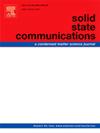探索用LiCoO2阴极活性材料和P2O5作为玻璃形成剂的玻璃化
IF 2.4
4区 物理与天体物理
Q3 PHYSICS, CONDENSED MATTER
引用次数: 0
摘要
寻找管理锂离子电池阴极活性材料(CAMs)的新策略是目前研究的一个活跃领域,因为锂离子电池在电动汽车方面的需求不断增加。在这项工作中,首次探索了使用锂钴(III)氧化物(LiCoO2)作为CAM和五氧化二磷(P2O5)作为玻璃原料剂的玻璃化(制造玻璃),以提供概念验证。在xLiCoO2-(100 - x)P2O5的引导下,按x = 20、25、30、35和40 mol%的公式,将原料按不同比例混合,在空气中熔化。随后通过x射线衍射(XRD)、密度、傅里叶变换红外(FT-IR)光谱、差示扫描量热(DSC)和光透射测量对所形成的材料进行了表征。该数据支持在所探索的成分范围内形成玻璃,其中密度随LiCoO2浓度的增加而增加。FT-IR数据表明,以P2O5为代价加入LiCoO2会导致网络解聚效应,例如链端PO4四面体的vas(PO32−)带的增加。DSC进一步表明,随着LiCoO2含量的增加,玻璃化转变温度稳步升高,而玻璃化稳定性下降。光学测量表明,在不同的配位环境中,钴离子的存在导致了总体透射率的下降。在此,提出了发展蓝色带通滤光片的玻璃的潜力。这项初步工作的开展激发了关于P2O5玻璃化的潜力的进一步研究,用于废旧锂离子电池LiCoO2正极材料的管理或升级回收。本文章由计算机程序翻译,如有差异,请以英文原文为准。
Exploring vitrification with LiCoO2 cathode-active material and P2O5 as glass forming reagent
The search for novel strategies to manage cathode-active materials (CAMs) from lithium-ion batteries (LIBs) is currently an active area of research given their increasing demand in electric mobility. In this work, vitrification (the making of glasses) using lithium cobalt(III) oxide (LiCoO2) as CAM and phosphorus pentoxide (P2O5) as glass former is explored for the first time to provide proof-of-concept. The raw materials were mixed in various proportions and melted in air atmosphere guided by xLiCoO2-(100 – x)P2O5 with x = 20, 25, 30, 35 and 40 mol% formulas. The materials formed were subsequently characterized by X-ray diffraction (XRD), density, Fourier-transform infrared (FT-IR) spectroscopy, differential scanning calorimetry (DSC), and optical transmission measurements. The data supported glass formation in the compositional range explored, wherein the densities tended to increase with LiCoO2 concentration. The FT-IR data suggested that incorporating LiCoO2 at the expense of P2O5 leads to a network depolymerization effect evidenced for instance by the upsurge of the vas(PO32−) band of end-of-chain PO4 tetrahedra. Further, DSC showed that the glass transition temperatures increased steadily while glass stability decreased with increasing LiCoO2 content. The optical measurements showed overall decreased transmittance ensued in connection with the presence of cobalt ions in different coordination environments. Herein, a potential for the glasses for developing blue bandpass filters is suggested. The preliminary work carried out stimulates further research concerning the potential of vitrification with P2O5 for the management or upcycling of the LiCoO2 cathode material from spent LIBs.
求助全文
通过发布文献求助,成功后即可免费获取论文全文。
去求助
来源期刊

Solid State Communications
物理-物理:凝聚态物理
CiteScore
3.40
自引率
4.80%
发文量
287
审稿时长
51 days
期刊介绍:
Solid State Communications is an international medium for the publication of short communications and original research articles on significant developments in condensed matter science, giving scientists immediate access to important, recently completed work. The journal publishes original experimental and theoretical research on the physical and chemical properties of solids and other condensed systems and also on their preparation. The submission of manuscripts reporting research on the basic physics of materials science and devices, as well as of state-of-the-art microstructures and nanostructures, is encouraged.
A coherent quantitative treatment emphasizing new physics is expected rather than a simple accumulation of experimental data. Consistent with these aims, the short communications should be kept concise and short, usually not longer than six printed pages. The number of figures and tables should also be kept to a minimum. Solid State Communications now also welcomes original research articles without length restrictions.
The Fast-Track section of Solid State Communications is the venue for very rapid publication of short communications on significant developments in condensed matter science. The goal is to offer the broad condensed matter community quick and immediate access to publish recently completed papers in research areas that are rapidly evolving and in which there are developments with great potential impact.
 求助内容:
求助内容: 应助结果提醒方式:
应助结果提醒方式:


